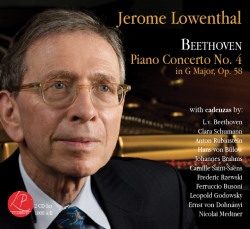
|
Ludwig van BEETHOVEN (1770-1827)
Piano Concerto No. 4 in G
major, Op. 58 (1805-06) Cadenzas by Beethoven, Clara Schumann, Anton Rubinstein, Hans von BŁlow, Brahms,
Saint-SaŽns, Rzewski, Busoni, Godowsky, von DohnŠnyi and Medtner.
Jerome Lowenthal (piano)
unnamed orchestra/Carl Topilow
rec. 2007, Cleveland, Ohio. DDD
LP CLASSICS 1008A/B [76:14 + 73:05]
This is a unique presentation of the Beethoven G major Piano Concerto. Each disc contains a complete performance of the concerto, followed by cadenzas written for this work by ten composers, including Brahms, Clara Schumann, Busoni and Saint-SaŽns. The soloist is the American pianist and teacher Jerome Lowenthal.
In his notes Lowenthal recounts a conversation in which a friend told him about a volume of cadenzas, last seen in Tel Aviv, by Romantic pianist composers and those of the modern period for the Beethoven G major concerto. Unknown to his companion, Lowenthal had just received this volume from his brother-in-law as a birthday present. The cadenzas in this set are all taken from this volume, except for that by the contemporary pianist and composer Frederic Rzewski. The latter offering, commissioned by Lowenthal, can be played in either the first movement or finale of Op. 58.
This set presents a number of unique possibilities. Before considering these, however, the performances should be discussed. Lowenthal and conductor Carl Topilow emphasise the lyrical side of the concerto; Daniel does not have to work very hard to subdue the lions in the Andante con moto. Consistent with this approach, the soloist plays in a fairly unruffled style, his fine legato and digital agility very much on display. Lowenthal’s playing avoids flashiness, but demonstrates his virtuoso chops throughout, particularly in the cadenzas, which are dispatched with verve. The un-named orchestra plays very well; I was guessing it to be a pick-up band comprising players from the Cleveland Orchestra. There was an odd sound-effect on one track like a muffled sneeze, but otherwise the recording is serviceable, albeit with a rather recessed bottom end. This impression was reinforced when I got out my old recording of Kempff/Leitner (DG), which has much more bass. Theirs is generally rather more energetic, particularly at the podium. Kempff, incidentally, follows the original practice of improvising his cadenzas, so I got to hear yet another couple. It is obviously a challenge as regards microphone placement having a concerto and solo works on the same disc. The cadenzas sound a bit distant, but the producers doubtless wanted to allow different cadenzas to be programmed with the concerto without creating audio anomalies.
I should make it clear that when I am referring to “performances”, I mean “the concerto and the cadenzas”. The timings indicate that the performance from Disc 1 is repeated on Disc 2 with the exception that the latter features the Rzewski cadenza. Duplicating the performance seems an odd thing to do when a sonata or two could have been included instead on the second disc. The rationale for repeating the concerto on the second disc, however, becomes clear. On both discs the first movement and finale are split into two tracks, Track 1 comprising the movement up to the cadenza, Track 2 the cadenza and coda. The additional cadenzas are also tracked separately, and all include the coda. Those who play straight through the disc will soon become familiar with the skip button on their remote control. It is possible therefore to programme multiple performances of the Beethoven G major concerto, each with a unique combination of first movement and finale cadenzas. How many combinations are there? I briefly tried to work this out, but soon enlisted the help of an engineer. After this I can report that the two discs allow about 120 possible combinations: 120 unique performances of the work.
Apart from stumping your guests at a dinner party, what are the possible uses of this set? For one thing, it offers a thorough survey of how composers went about writing cadenzas for this work. It also offers a good sample of the rarely heard Romantic composer-pianists Busoni, Godowsky, DohnŠnyi and Medtner, and gives a hint of how they might have performed this work. None was trying to write like Beethoven, so the effect is a bit like seeing a period house with an extension by a later architect.
Lowenthal gives a satisfying performance of the concerto, and makes a convincing case for reviving these cadenzas. For anyone studying or teaching the Beethoven G major concerto, or interested in Romantic pianism, this is an indispensable resource.
Guy Aron
 |
 |
|
